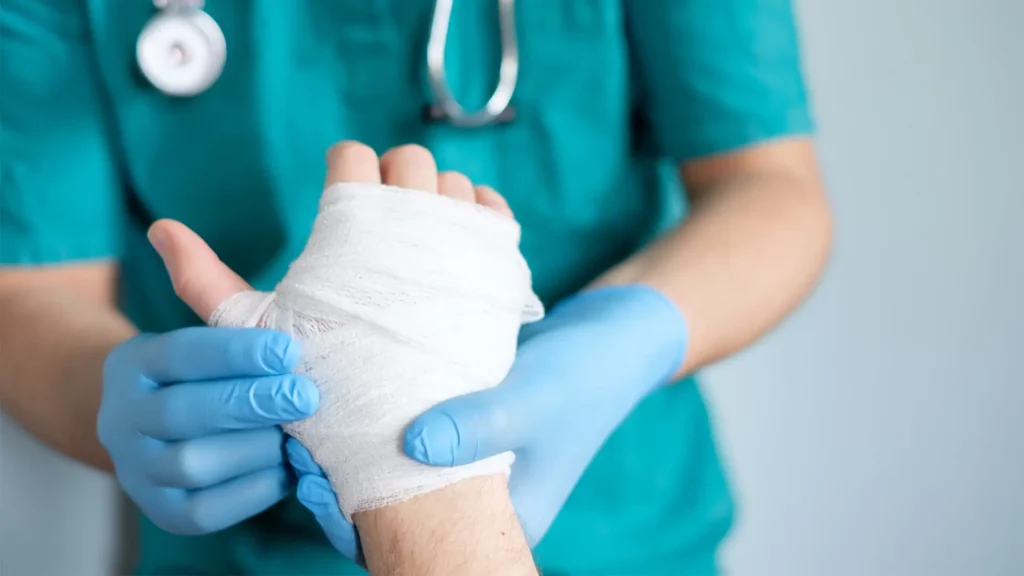Work-related injuries and accidents are unfortunate but common occurrences in many industries. Whether it’s a minor cut, a serious fall, or exposure to harmful substances, the aftermath requires appropriate medical care to ensure a full recovery. Understanding the types of medical care needed after work-related injuries and accidents is crucial for employees and employers alike. This blog post covers immediate first aid, ongoing treatment, and rehabilitation necessary for recovery.
Immediate First Aid
The first step in managing work-related injuries is providing immediate first aid. Prompt and appropriate first aid can minimize the severity of the injury and prevent complications.
Basic First Aid Steps
- Assess the Situation: Before administering first aid, assess the scene for any ongoing dangers. Ensure it is safe to approach the injured person.
- Call for Help: Contact emergency services if the injury is severe or life-threatening. Inform them of the nature and extent of the injury.
- Provide Care: Depending on the injury, perform the necessary first aid steps:
- Cuts and Scrapes: Clean the wound with water, apply antiseptic, and cover with a sterile bandage.
- Burns: Cool the burn with running water for at least 10 minutes, cover with a clean cloth, and avoid applying ice or creams.
- Sprains and Strains: Rest the injured area, apply ice to reduce swelling, compress with a bandage, and elevate if possible.
- Fractures: Immobilize the injured area, avoid moving the person unnecessarily, and wait for medical professionals.
Medical Evaluation and Diagnosis
After providing first aid, it’s essential for the injured worker to receive a thorough medical evaluation. This evaluation helps determine the extent of the injury and the appropriate treatment plan.
Visiting a Healthcare Professional
- Primary Care Physician: For minor injuries, visiting a primary care physician might be sufficient. They can assess the injury, provide treatment, and refer to specialists if needed.
- Urgent Care Centers: For injuries that are not life-threatening but require immediate attention, urgent care centers are a good option. They can handle a variety of injuries and provide prompt care.
- Emergency Room: For severe injuries such as fractures, deep cuts, head injuries, or any condition that poses an immediate threat to life or health, the emergency room is the best place to seek medical attention.
Diagnostic Tests
Healthcare professionals may order diagnostic tests to better understand the injury and plan the appropriate treatment. Common tests include:
- X-rays: Used to detect fractures, dislocations, and other bone injuries.
- MRI Scans: Provide detailed images of soft tissues, including muscles, ligaments, and internal organs.
- CT Scans: Offer comprehensive cross-sectional images of the body, useful for diagnosing complex injuries.
- Ultrasound: Helps in examining soft tissues and detecting internal bleeding or damage.
Treatment and Ongoing Care
After diagnosis, the next step is implementing a treatment plan tailored to the specific injury. Treatment can vary widely depending on the nature and severity of the injury.
Medication
- Pain Relievers: Over-the-counter or prescription pain relievers may be recommended to manage pain and discomfort.
- Anti-Inflammatories: Medications like ibuprofen can help reduce inflammation and swelling.
- Antibiotics: For cuts, scrapes, or injuries that break the skin, antibiotics may be prescribed to prevent infection.
Physical Therapy
Physical therapy is often a crucial component of the recovery process, especially for musculoskeletal injuries. A physical therapist can develop a personalized exercise plan to:
- Improve Mobility: Help restore movement and flexibility to the injured area.
- Strengthen Muscles: Build strength in the affected muscles to support recovery and prevent future injuries.
- Enhance Functionality: Assist in regaining the ability to perform daily activities and job-related tasks.
Surgery
In some cases, surgery may be necessary to repair the injury. This could include:
- Fracture Repair: Surgical intervention to realign and stabilize broken bones.
- Tendon or Ligament Repair: Reconstructive surgery to repair torn tendons or ligaments.
- Internal Organ Repair: Surgery to address internal injuries resulting from blunt force or penetrating trauma.
Rehabilitation and Recovery
Rehabilitation is a critical phase of the recovery process, focusing on restoring the injured worker to their pre-injury state.
Occupational Therapy
Occupational therapy helps individuals regain the skills needed for daily living and working. An occupational therapist can assist with:
- Ergonomic Assessments: Evaluating the workplace and recommending modifications to prevent further injury.
- Work Conditioning: Developing a program to help the injured worker gradually return to their job tasks.
- Adaptive Techniques: Teaching techniques to perform tasks safely and efficiently.
Psychological Support
Work-related injuries can have a significant impact on mental health. Psychological support, including counseling and therapy, can help address issues such as:
- Anxiety and Stress: Managing the emotional response to the injury and its impact on life and work.
- Depression: Providing support for those who feel overwhelmed or depressed due to their injury.
- Coping Strategies: Developing strategies to cope with the changes and challenges brought by the injury.
Preventing Work-Related Injuries
While the focus of this blog is on medical care after an injury, prevention is equally important. Employers and employees should work together to create a safe working environment.
Safety Training
- Regular Training: Conduct regular safety training sessions to keep employees informed about best practices and safety protocols.
- Emergency Drills: Perform emergency drills to ensure everyone knows how to respond in case of an accident or injury.
Workplace Safety Measures
- Protective Equipment: Provide and enforce the use of appropriate personal protective equipment (PPE) for the job.
- Ergonomic Workspaces: Design workspaces to reduce strain and prevent injuries, especially for jobs that involve repetitive motions or heavy lifting.
- Safety Inspections: Conduct regular safety inspections to identify and address potential hazards in the workplace.
Legal and Administrative Steps
After a work-related injury, there are also legal and administrative steps that need to be taken to ensure the injured worker receives the necessary care and compensation.
Reporting the Injury
- Notify Employer: The injured worker should report the injury to their employer as soon as possible, providing details of how and when it occurred.
- Document the Incident: Both the employer and employee should document the incident, including any witnesses and the circumstances leading to the injury.
Workers’ Compensation Claims
Workers’ compensation is a form of insurance that provides medical benefits and wage replacement to employees injured on the job.
- Filing a Claim: The injured worker needs to file a workers’ compensation claim with their employer or the relevant government agency.
- Medical Documentation: Provide thorough medical documentation to support the claim, including diagnosis, treatment plans, and any work restrictions.
Returning to Work
Returning to work after a work-related injury should be a carefully managed process to prevent re-injury and ensure a smooth transition.
Light Duty Assignments
- Modified Tasks: Employers may provide light duty assignments that accommodate the worker’s current physical capabilities.
- Gradual Return: Gradually increase the workload and responsibilities as the worker’s condition improves.
Follow-Up Care
- Regular Check-Ups: Schedule regular follow-up appointments with healthcare providers to monitor progress and adjust treatment as needed.
- Ongoing Therapy: Continue with physical or occupational therapy until the worker has fully recovered.
Summary
Work-related injuries and accidents require prompt and appropriate medical care to ensure a full recovery. Immediate first aid, thorough medical evaluation, and a tailored treatment plan are essential steps in managing these injuries. Incorporating physical therapy, occupational therapy, and psychological support can significantly enhance the recovery process. Prevention measures and safety training can help reduce the risk of workplace injuries. Employers and employees should work together to create a safe working environment, ensuring that any injuries that do occur are managed effectively and that injured workers receive the necessary care and support to return to work safely.

